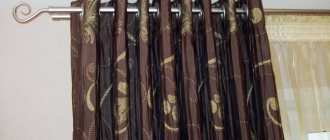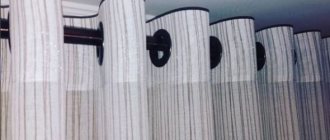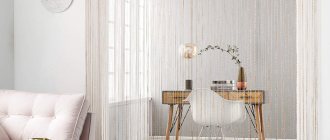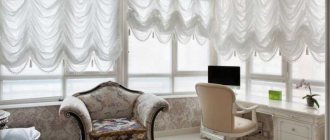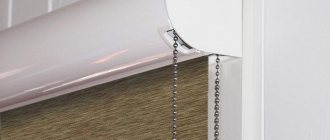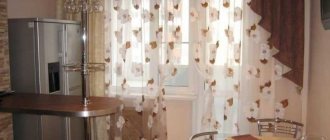Eyelets on curtains look stylish and original. This design is a unique example of a window opening interior, which is often one of the main design motifs, emphasizing its originality and expressiveness. And sometimes it plays the role of an independent decorative element of any room. Easy to install and easy to use, eyelet curtains are similar to blinds. They can be easily put on and removed from the curtain rod. But the main thing is that anyone can make such a curtain with their own hands. Ease, reliability and accessibility in installing eyelets, as well as step-by-step instructions on how to correctly install rings on curtains, will make the dream of a beautiful window a reality, help consolidate new useful skills and, importantly, significantly save money on designer services.
Advantages of curtains with eyelets
There are several reasons why you should choose eyelets as fastenings:
- Easy to use. Metal or plastic rings slide easily along the curtain rod; even a child can close the curtains;
- Strength. The metal does not bend even if you pull the curtain hard. High-quality fittings will last up to 10 years;
- Beauty. Curtains with eyelets with tulle or other fabric lie in even folds. And the rings themselves can be selected in different sizes, colors and shapes.
Which rings are better, metal or plastic?
Many people believe that plastic rings are better than metal ones. They explain this by saying:
- they are easier to install because they snap easily into place, requiring no special equipment;
- After prolonged use, there is no trace left on the curtains, as they do not rust.
Proponents of metal eyelets argue that if the rings are made of high quality ferrous or non-ferrous metal, then the above mentioned comments have no meaning. Plus, the following products:
- stronger;
- more reliable;
- may last longer.
Such curtains fit perfectly into a modern interior.
Types of eyelets
The eyelet is a design of two rings with a latch. The fabric is placed between the rings and secured. Eyelets are made of metal, plastic and wood.
The most practical are plastic eyelets. High-quality plastic does not crumble or corrode, so the curtains can be washed directly along with the fastenings. Another plus is noiselessness. When sliding along the cornice, the plastic rings rustle slightly.
Wooden and metal eyelets without special coating are afraid of water and move much noisier.
On sale there are eyelets with imitation of various metals (gold, silver, platinum, chrome), sometimes they are complemented with rhinestones or a pattern. The most popular shapes are round eyelets, but there are also square and triangular ones.
Eyelets can also vary in internal diameter. It should be 5-10 mm larger than the diameter of the cornice pipe so that the curtains slide easily over it. The outer ring serves a decorative function, and its thickness only affects the appearance of the fastener.
How to wash properly
Let's consider another question that interests many: how to properly wash curtains with plastic or metal rings.
They are much easier to remove and hang back after washing, which is a big advantage compared to regular curtains.
Machine washable
First you need to find out whether curtains with rings can be washed in a washing machine. It is best to place the curtains in a special washing bag to prevent the rings from damaging the drum. If this bag is not available, a regular pillowcase will replace it. If the rings are of high quality, rust will not appear on them. Tulle is not wrung out after washing; it is hung wet.
Hand wash curtains
If you don’t want to risk curtains and the washing machine, wash the curtains by hand. To do this, without removing the rings, soak the curtains in lukewarm water for 2 hours, and then rinse thoroughly so that there are no streaks left. You definitely won't get them from regular shampoo.
Sometimes it happens that when washing in a machine, the fabric may come out from under the eyelets, but usually this is only due to their incorrect installation during sewing. The problem is easily solved by reinstalling the incorrectly secured grommets.
Preliminary calculations
Before making eyelets for curtains, you need to calculate the footage of the fabric. The length of the canvas should start from the edge of the cornice and end, not reaching 3-5 cm to the floor. If we are talking about kitchen curtains, the length reaches the window sill. For the hem, leave 5 cm at the bottom, leave a width at the top equal to the outer diameter of the eyelet + 5 cm.
The width of the canvas is calculated depending on the type of fabric. In order for eyelet curtains to look like the photos from fashion magazines, they must fold in beautiful wide folds. For tulle, the length of the cornice is multiplied by 1.5; for denser fabrics, the length of the cornice is multiplied by 2.
Description
A grommet is an element that allows you to strengthen the edges of any material. It is a bushing with a cap on one side and an overhead washer on the other. There is a hole inside the product that is used for threading thread, rope, bowstring, or simply as a decorative decoration.
The eyelet consists of two parts - a ring and a bushing, also known as a block
Installation of eyelets is carried out in factories or manufacturing plants of various products. This element of attributes of each individual item has been widely used in several industries. Without this amplifier it is impossible to imagine ordinary shoes, or a modern notebook with recipes for a housewife.
Eyelets are used:
- in the production of outerwear;
- for making shoes;
- when producing home furnishing goods;
- for tourism and holiday purposes;
- in commercial activities;
- in the manufacture of shipping and maritime products;
- in office and printing.
As can be seen from the description of the areas of use of this wonderful accessory, it is widely used in almost all industries producing goods. Basically, the device is functional in nature, which consists in strengthening the edges of the material for subsequent threading of rope, cable or thin thread through it.
To install eyelets yourself, you need to know what hardware factories make them from.
- Steel.
- Aluminum.
- Brass.
- Copper (rare).
- Silver.
- Gold.
- Tree.
- Plastic.
- Stitching with thread.
Amplifiers are made from expensive metals by jewelry craftsmen or jewelry factories. Such elements serve as decorations for bracelets, shoulder straps of bags, shoes, and designer clothes. Aluminum products, as well as brass, are used for office/printing activities. Quarterly calendars, scrapbooks, notebooks and other products can be modified using eyelets.
Interesting. In the office, such a strengthening attribute is called a block. The printing industry workers themselves call it a “piccolo” ring.
A block is a grommet without a ring
Calculation of fastenings
All master classes on sewing curtains with eyelets say that for each linear meter of curtain there should be 6 eyelets.
The outer rings should be placed at a distance of 2-3 cm from the edge of the curtain so that the folds begin from the very beginning. Based on this, subtract 6 cm from the width of the canvas and divide the resulting figure by 6. You will get the number of eyelets you will need to buy.
Next you need to calculate the distance between the rings. To do this, divide the width by the number of eyelets and subtract the diameter of the outer ring of the eyelet from the resulting figure.
Conclusion
Installing eyelets at home will not be difficult even for a less experienced craftswoman. The main thing is to carefully carry out simple calculations, select the necessary fabric, buy a seal and the required number of fasteners.
The work begins with trimming the fabric and finishing all the seams. The eyelets are attached to the finished ironed curtain. First, the outer fasteners are installed, and then all the rest. A little patience - and the curtain is ready!
Practical tips for making light filters for windows with your own hands
How to make curtains from beads with your own hands?
How to make wooden blinds with your own hands?
Installation of eyelets
- Draw a straight line on the underside of the cuff with chalk or a piece of soap on which the fasteners will be located;
- Mark the locations for each of the eyelets;
- Trace the eyelets along the inner diameter;
- Using sharp scissors, cut each hole slightly beyond the drawn circle;
- Turn the curtain over so the front side is facing you;
- Place the wrong side of the eyelet under the bottom of the fabric;
- Place the front part on top;
- Press lightly until you hear a characteristic click;
- Repeat for each of the fasteners.
"Tails" and garters
How to sew “tails” and tie-backs for curtains with rings?
The side and bottom sections are processed, folded twice on the wrong side, 1 cm each, and stitched to the edge. The product will be ironed. The “tails” are superimposed on each other with an overlap of 10 cm and secured in this position. The soft part of the Velcro tape is sewn onto the upper sections of the “tails”, which is attached to the front side of the fabric, turned to the wrong side and secured along the entire length with two lines. The product will be ironed.
The rectangular piece is folded lengthwise with the front side inward. The longitudinal sections are ground down, the workpiece is turned inside out, and the edges are sutured. You should get a tie measuring 20 X 98 cm, which is tied in the middle with a weak knot.
Tulle and curtains are hung on the corresponding curtain rods. The curtain is tied with a drawstring. When attaching curtains to rings, a rigid part of the Velcro tape is glued to the upper part of the cornice. “Tails” are attached to it, onto which drapery rings are put on. The lower part of the “tails” straightens out.
0 Comments
